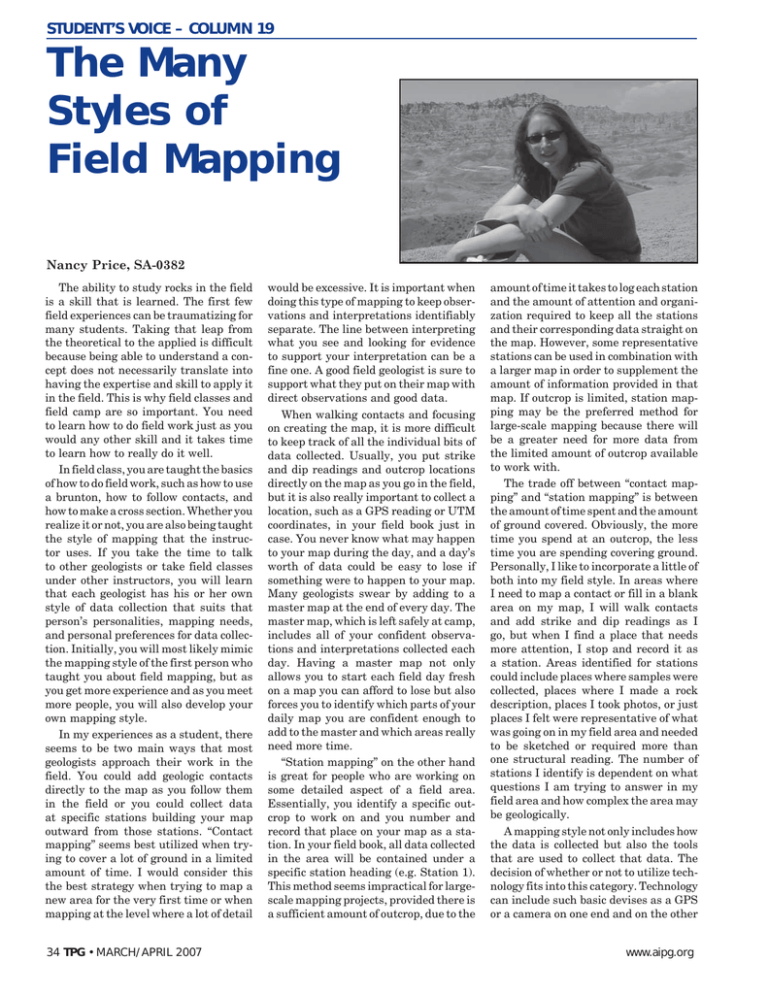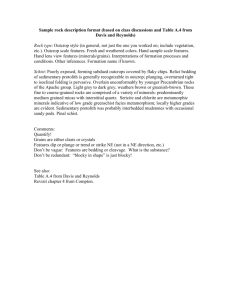The Many Styles of Field Mapping
advertisement

STUDENT’S VOICE – COLUMN 19 The Many Styles of Field Mapping Nancy Price, SA-0382 The ability to study rocks in the field is a skill that is learned. The first few field experiences can be traumatizing for many students. Taking that leap from the theoretical to the applied is difficult because being able to understand a concept does not necessarily translate into having the expertise and skill to apply it in the field. This is why field classes and field camp are so important. You need to learn how to do field work just as you would any other skill and it takes time to learn how to really do it well. In field class, you are taught the basics of how to do field work, such as how to use a brunton, how to follow contacts, and how to make a cross section. Whether you realize it or not, you are also being taught the style of mapping that the instructor uses. If you take the time to talk to other geologists or take field classes under other instructors, you will learn that each geologist has his or her own style of data collection that suits that person’s personalities, mapping needs, and personal preferences for data collection. Initially, you will most likely mimic the mapping style of the first person who taught you about field mapping, but as you get more experience and as you meet more people, you will also develop your own mapping style. In my experiences as a student, there seems to be two main ways that most geologists approach their work in the field. You could add geologic contacts directly to the map as you follow them in the field or you could collect data at specific stations building your map outward from those stations. “Contact mapping” seems best utilized when trying to cover a lot of ground in a limited amount of time. I would consider this the best strategy when trying to map a new area for the very first time or when mapping at the level where a lot of detail 34 TPG • MARCH/APRIL 2007 would be excessive. It is important when doing this type of mapping to keep observations and interpretations identifiably separate. The line between interpreting what you see and looking for evidence to support your interpretation can be a fine one. A good field geologist is sure to support what they put on their map with direct observations and good data. When walking contacts and focusing on creating the map, it is more difficult to keep track of all the individual bits of data collected. Usually, you put strike and dip readings and outcrop locations directly on the map as you go in the field, but it is also really important to collect a location, such as a GPS reading or UTM coordinates, in your field book just in case. You never know what may happen to your map during the day, and a day’s worth of data could be easy to lose if something were to happen to your map. Many geologists swear by adding to a master map at the end of every day. The master map, which is left safely at camp, includes all of your confident observations and interpretations collected each day. Having a master map not only allows you to start each field day fresh on a map you can afford to lose but also forces you to identify which parts of your daily map you are confident enough to add to the master and which areas really need more time. “Station mapping” on the other hand is great for people who are working on some detailed aspect of a field area. Essentially, you identify a specific outcrop to work on and you number and record that place on your map as a station. In your field book, all data collected in the area will be contained under a specific station heading (e.g. Station 1). This method seems impractical for largescale mapping projects, provided there is a sufficient amount of outcrop, due to the amount of time it takes to log each station and the amount of attention and organization required to keep all the stations and their corresponding data straight on the map. However, some representative stations can be used in combination with a larger map in order to supplement the amount of information provided in that map. If outcrop is limited, station mapping may be the preferred method for large-scale mapping because there will be a greater need for more data from the limited amount of outcrop available to work with. The trade off between “contact mapping” and “station mapping” is between the amount of time spent and the amount of ground covered. Obviously, the more time you spend at an outcrop, the less time you are spending covering ground. Personally, I like to incorporate a little of both into my field style. In areas where I need to map a contact or fill in a blank area on my map, I will walk contacts and add strike and dip readings as I go, but when I find a place that needs more attention, I stop and record it as a station. Areas identified for stations could include places where samples were collected, places where I made a rock description, places I took photos, or just places I felt were representative of what was going on in my field area and needed to be sketched or required more than one structural reading. The number of stations I identify is dependent on what questions I am trying to answer in my field area and how complex the area may be geologically. A mapping style not only includes how the data is collected but also the tools that are used to collect that data. The decision of whether or not to utilize technology fits into this category. Technology can include such basic devises as a GPS or a camera on one end and on the other www.aipg.org STUDENT’S VOICE – COLUMN 19 end more complex and expensive data collecting or storing devises, such as laptops. Electronics can make our lives easier and more simplified, but can also make us lazy, can bog us down, and can break when we need them most. I always include a digital camera and a GPS as parts of my field gear, but I never rely on just these things to collect my data. For every position point I store on my GPS, I also copy it into my field book for safekeeping. I sketch important outcrops in my field book before I take a picture of it so that I know what I am taking a picture of and why. You can’t draw strike and dips on a digital photo in the field but you can on a sketch in your book. The decision to use technology is a personal one based on your own level of efficiency and accuracy. The key is to be sure that each piece of technology you are using is a tool to enhance your field experience rather than just a toy that controls it. Work in the field really hinges on your own personal level of organization as well. For some people, a stable level of chaos feeds discovery and innovation. I am not one of those people. If I don’t have focus in my day, then I don’t get as much done. At the end of each field day while you are going over what you did that day and recording necessary information on your compilation map while it is still fresh, you can also be planning for your next field day. Identify those areas that still need your attention. What questions still haven’t been answered and what needs to be done to answer them? Create a realistic goal for the next day and set yourself to achieving it. If you have something to work towards in the field, your mind will be focused instead of swimming. This will be one way to keep yourself from sitting on the outcrop agonizing over where you are going to go next. Perhaps the most important advice that I received when preparing for my first field season, however, had nothing to do with field skills at all. I was told to take care of myself. It seems like an intuitive piece of advice, but it can be really easy to forget that a day in the field is more physically demanding than a day in the office. The more you hike around, the more calories you will need to take in. The hotter it is outside and the more you perspire, the more water you will need. It is essential to eat a good meal at least once a day and drink plenty of water (or even gatoraid) to keep up your mental and physical strength. Taking care of yourself is not limited to just eating right, it also refers to taking care of your body while in the field. For example, don’t carry more in your pack than you can handle. Injuries only slow you down, make you uncomfortable, or could even cut your field season short. Also, it is unreasonable to think that you can spend 12 hours in the field everyday at your top performance for weeks and weeks at a time. Unless it is absolutely necessary, a long day spent in the field only wears you out and does not give you time to prepare for the next day. Figuring out what your own field style is will take a lot of floundering. No one can tell you what works best for you and there probably won’t be anyone around with the time available to really try. Your first field experience may not be pretty. You will make mistakes and spend more time than you want trying to figure out where to go next. The only real solace that I have for you is that everyone has to go through it and that you will get better every day you are out there. If you have any ideas, questions, or comments about this article or any other issues, please feel free to contact me via email at: nancyaprice@yahoo.com. STUDENT APPLICATION FORM www.aipg.org MARCH/APRIL 2007 • TPG 35

